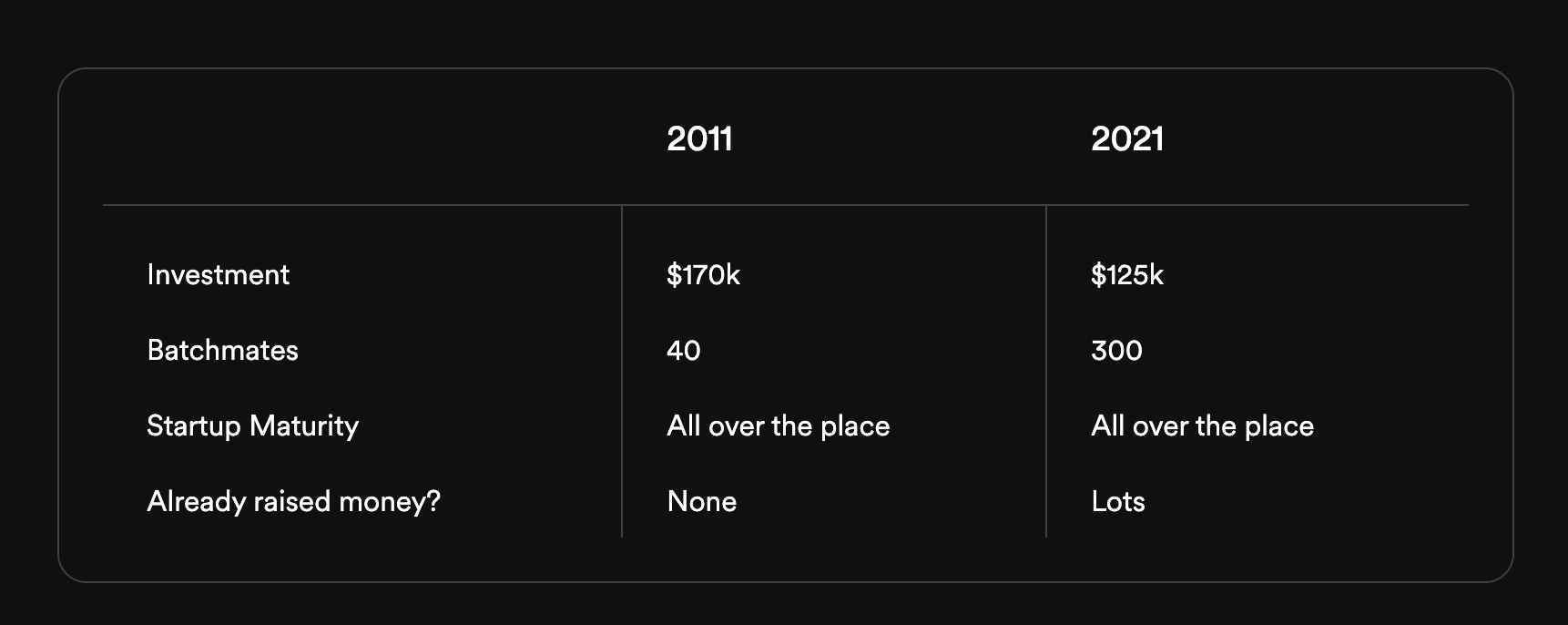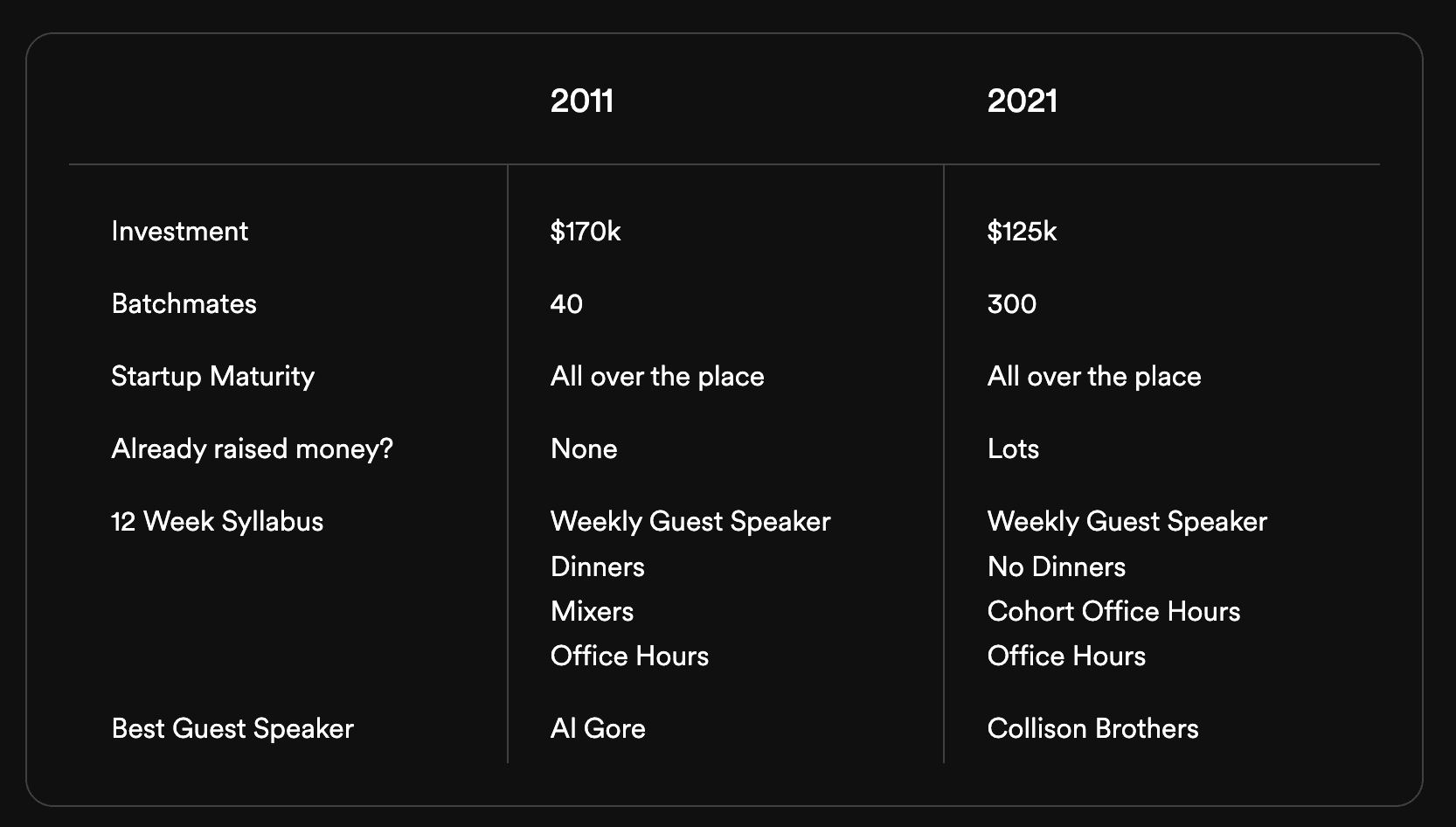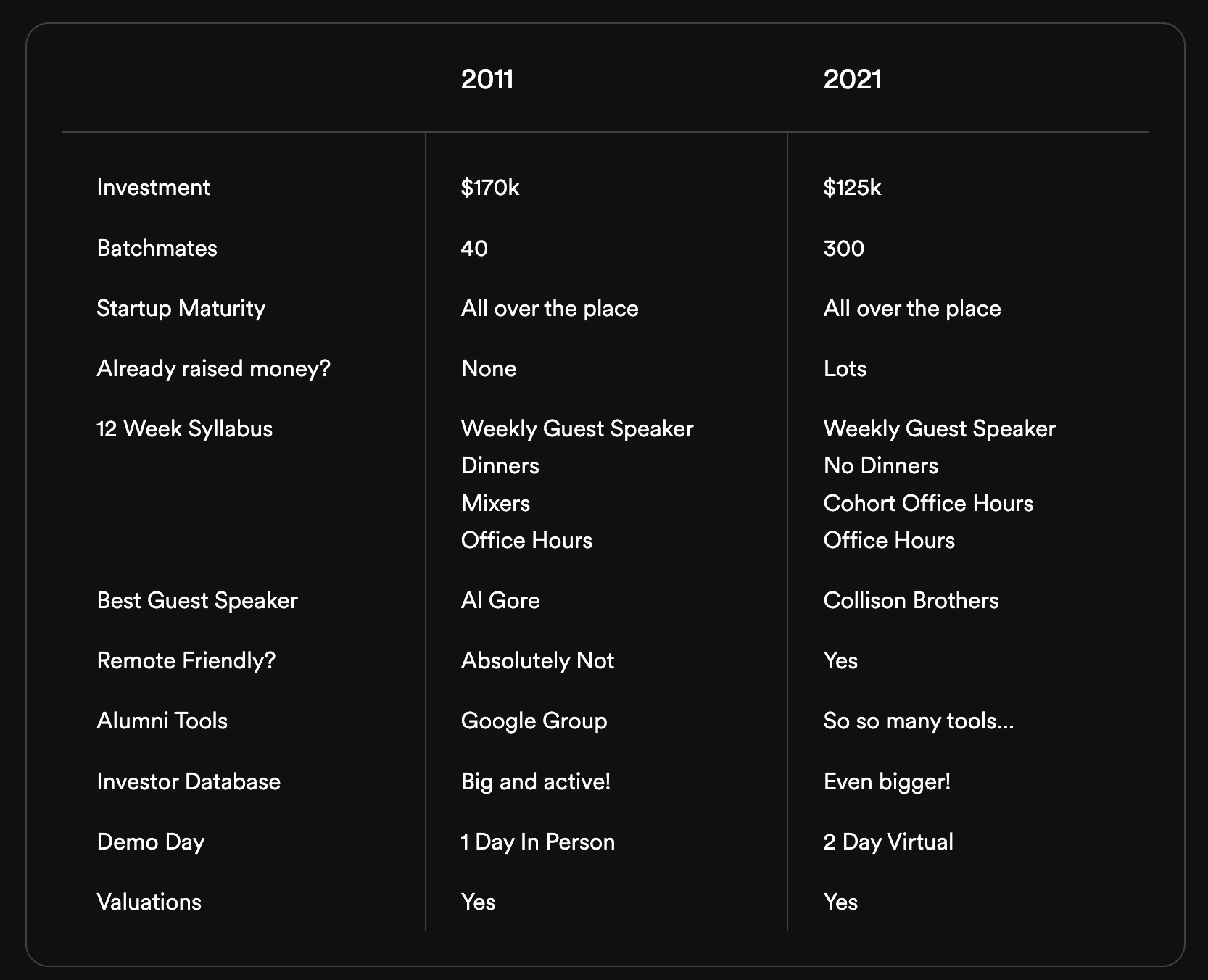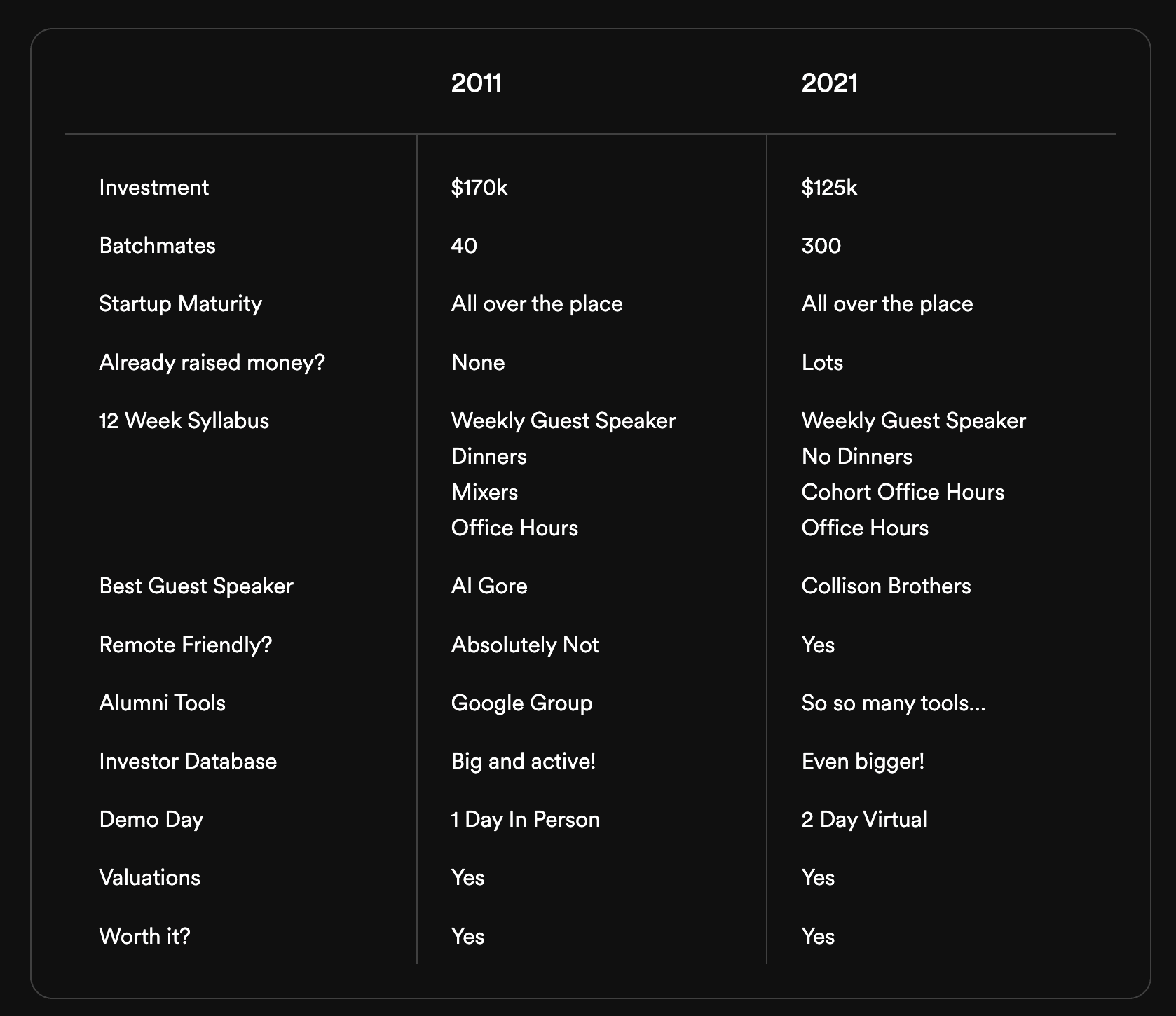October 20, 2022

As I started my journey (hey!) into startups in 2009, I became an avid reader of Hacker News (at some point breaking their top 100 users of karma) and thus also Paul Grahams essays. At the same time, I met more and more founders that went through Y Combinator: Songkick, Webmynd, Rapportive, and all spoke very highly of the program.
I applied for the first time in early 2010 and was rejected, but on my second application in late 2010, my co-founder and I were accepted.
We ended up postponing Y Combinator by about six months and I’ll never forget Paul Graham emailing me out of the blue asking how things were going and I was terrified that they were going to rescind our place, so I said along the lines of “very excited to do Y Combinator” and Paul Graham replied in a matter of minutes with something like “you’re in Y Combinator, do not worry about that.”
The Deal
It turns out that by delaying to do Y Combinator meant that we ended up in the first Y Combinator batch where every company received $150k in addition to the typical $20k Y Combinator investment. $150k may seem fairly paltry in 2022, but in 2011 let me tell you: it was a ton of money!
As an example, in 2022, Y Combinator startups now get $500k. Given how much the startup world has exploded in the last decade, $150k ten years ago seems all the more giant.
The Batch Size
There were approximately 40 companies in our batch in Summer 2011. At the time, again, this felt like a ton. We idly worried: has Y Combinator diluted its brand by investing in so many companies?
(As a side note, I initially wrote that that Summer 2011 was the first batch where the batch size increased “dramatically” (my words), but in researching this, it seems like the previous batch had approx 36 companies, so perhaps the batch size was relatively constant, but this was the first batch that received a larger initial investment ( read more about that here.))
The irony is that when I went through Y Combinator in 2021 … the batch size was north of 300 companies.

The 12 Weeks

The actual 12 week syllabus for Y Combinator didn’t really change. In 2011 there was:
A weekly guest speaker
A weekly mixer and dinner (before and after the speaker)
Optional office hours (you were encouraged to have 1 per week)
I believe in the next batch Y Combinator introduced Group Office Hours, where multiple companies attend office hours together — this seems like a great idea.
In 2021 the syllabus was:
A weekly guest speaker
A weekly office hours for your entire cohort (since there were 400 companies, the batch was broken into 10-15 smaller cohorts)
Optional office hours
In both 2011 and 2021 it was amazingly insightful to just casually swap notes with other startups and be able to ask them point blank how things were going. In 2011, the weekly office hours were simply my startup meeting with a Y Combinator group partner and it often felt like you were withering under the polite and thoughtful gaze of the partner. In 2021, the weekly office hours were ~8 companies and it consistently felt a little too big to be candid.
The Talks
The weekly talks were consistently pretty good, memorable and fun — in 2011 Al Gore spoke, and considering he invented the internet, that is a tough bar to beat. In 2021 it was amazingly inspiring that basically all the speakers were Y Combinator alumni.

The Biggest Differences
Remote vs. Local
I was 22 when I moved from England to San Francisco to go through Y Combinator in 2011 — I actually couldn’t afford my plane ticket and had to borrow some money from family — 2-3x a week my co-founder and I would drive down 101 and head to Mountain View for office hours, batch events, weird dinners, and more.
A decade later, I attended Y Combinator remotely from the Pacific North West.
A British friend of mine, Jon, went through Y Combinator in 2009 with a company called DailyBooth, and was denied entry into the USA — he ended up going through Y Combinator from his wardrobe in the UK. Since then, I’d always known that doing Y Combinator remotely was possible, and I was excited to follow in his path albeit in a slightly more spacious workspace.
I think remote is a really really really complicated situation. Remote allows people to do things they wouldn’t otherwise be able to do — I had moved to the Pacific North West from San Francisco about a year ago, so there was really no way for me to move back to San Francisco — such convenience matters more and more as Y Combinator continues to fund established companies, immigrants, parents, and such.
That said, you do miss a lot of the impromptu bonding and water cooler talk. I remember randomly bumping into founders on Caltrain, around Menlo Park and it always being a fun bonding experience.
If I had to give feedback to Y Combinator it would be that surely there is some middle ground between all-in-person and all-remote. For example everyone could fly in for a kick off, or have regional meet ups. It’s constantly amazing how much chemistry is built in a short period with face to face interactions.

Alumni
In 2011 the YC alumni directory was still forming — it had a very active Google Group email list — in 2021, the amount of resources alumni have is downright ridiculous. Without going into too much detail there’s an incredibly active forum — 22 new topics in the last 24 hours — and a directory of founders that can be filtered in all sorts of ways.
It’s clear that in 2021 the biggest reason you do Y Combinator is to access this community. Companies ideate, launch and find product-market-fit without doing any marketing aside from to the community. If you cannot find dozens of users from the directory, something has gone awry with your product vision.

Demo Day
Admittedly we didn’t present at 2021 Demo Day because we raised before, but whereas the 2011 demo day was an investor-palooza in Mountain View, the 2021 demo day was a remote affair. Given the sole purpose of demo day is to capture investor details, I think having this be remote is pretty smart since it’s so efficient. I remember scrambling around for business cards and such in 2011 — whereas now there’s an elegant CRM of sorts to automagically warm intro founders and investors.
There’s been a dozen and one posts about valuations and such, all I’ll say is that in both 2011 and 2021 the average valuation felt surprisingly normal, and that in both demo days, I believe, some companies failed to raise. Raising is a privilege not a right, even during Y Combinator!
Both times, regardless of how much the world tells you not to, I spoke with many founders that were obesssed about having a certain valuation or some other odd optimisation (like not having too many or too few investors) — some things never change!

In Summary
In 2011, Y Combinator was a life changing 12 week program. My startup graduated not the hottest (that accolade probably went to Genius.com) but also not a train wreck.
Similarly in 2021, my startup graduated not the hottest (interestingly the batch was so large and remote, it’s hard to name who was the hottest) but also not a train wreck.
There’s another post to be written about the value of doing Y Combinator twice, but my other two co-founders, who had not previously gone through Y Combinator, were as effusive about the benefits of Y Combinator as I was.


